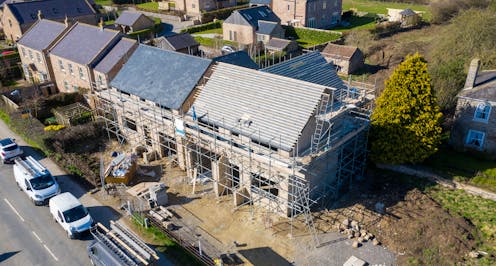Starmer and Sunak agree the UK needs more houses to ease the crisis – here’s how their plans compare
- Written by Alan Shipman, Senior Lecturer in Economics, The Open University

Aiming to reclaim his party’s role as the builders of “property-owning democracy”, Rishi Sunak used the Conservative manifesto launch to praise his predecessor Harold Macmillan. As Winston Churchill’s housing minister in the 1950s, Macmillan first set the target of completing more than 300,000 homes[1] across the UK each year.
Now that same target[2], although ambitious, must be achieved to meet the UK’s demand for new housing, and to make homes more affordable[3].
After peaking at more than 400,000 in the late 1960s, new home delivery trended downwards[4], dipping below 200,000 in 1990 and recovering above that total only in 2004-7 and from 2019.
The number of new homes built in England dropped to 189,260 last year and averaged just 164,450 from 2019-23. So, the Conservative manifesto promise[5] to “deliver 1.6 million homes in England in the next parliament” implies an immediate doubling of that completion rate, to 320,000 per year.
Labour’s plans[6] are slightly less ambitious, pledging 1.5 million new homes in the next parliament – but that’s still 50% more than were completed during the last one. Recognising that councils were the driving force behind Macmillan’s building boom, Labour would reintroduce the mandatory targets for local authorities that were scrapped last year.
There is cross-party consensus that first-time buyers (FTBs) need more help to get on the property ladder, with the average home price in England having increased by 173%[7] (253% in London) in real terms since 1997. At the same time, the average wage for 25- to 34-year-olds has risen by just 19%[8].
The Conservatives are offering a revival and expansion of “Help to Buy”[9], a scheme that loans FTBs up to 20% of the sale price and shares any capital gain (or loss) with the Treasury. The Tories would also extend FTBs’ exemption from stamp duty to purchases up to £425,000 (from £300,000 currently).
Labour plans to make it easier for FTBs to borrow commercially by launching a mortgage guarantee scheme[10], drawing on the US approach[11] where government mortgage guarantees enable lower-income households to borrow affordably. Labour also aims to give local buyers priority by stopping foreign investors[12] snapping up new developments, and by charging them additional stamp duty.
But FTB support schemes have been criticised for fuelling the demand for housing without ensuring additional supply. Recent analysis suggests the largest housebuilders have used price-setting power[13] to boost their profits via Help to Buy and other planning relaxations.
References
- ^ 300,000 homes (conservativehome.com)
- ^ target (www.gov.uk)
- ^ more affordable (www.ons.gov.uk)
- ^ trended downwards (www.ons.gov.uk)
- ^ manifesto promise (public.conservatives.com)
- ^ Labour’s plans (labour.org.uk)
- ^ 173% (lordslibrary.parliament.uk)
- ^ 19% (lordslibrary.parliament.uk)
- ^ “Help to Buy” (public.conservatives.com)
- ^ mortgage guarantee scheme (labour.org.uk)
- ^ US approach (www.cbo.gov)
- ^ foreign investors (labour.org.uk)
- ^ price-setting power (theconversation.com)
- ^ election newsletter (theconversation.com)
- ^ Barker Review (assets.publishing.service.gov.uk)
- ^ new planning powers (labour.org.uk)
- ^ Conservatives (public.conservatives.com)
- ^ those (www.bbc.co.uk)
- ^ Cambridge (www.gov.uk)
- ^ 50,000 (www.citb.co.uk)
- ^ building materials (www.homebuilding.co.uk)
- ^ quality (www.ciob.org)
- ^ Affordable Homes Programme (www.housing.org.uk)
- ^ drop in owner-occupation (www.theguardian.com)
- ^ hefty chunk (conservativehome.com)
- ^ social housing stock (commonslibrary.parliament.uk)
- ^ “no fault” evictions (england.shelter.org.uk)
- ^ faster (www.ons.gov.uk)
- ^ economy buoyant (www.bankofengland.co.uk)







